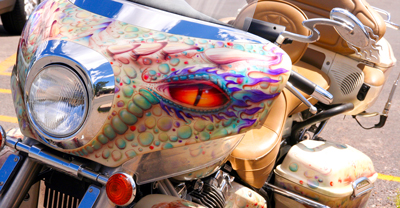Understanding motorcycle gross vehicle weight ratings (GVWR)


0 min. read
Knowing how much weight your motorcycle can safely carry isn’t just about checking a number in the manual—it’s a key part of riding safely. From short city trips to longer rides with a passenger or cargo, staying within your bike’s gross vehicle weight rating (GVWR) helps keep your motorcycle stable, responsive, and ready for the road.

Get a motorcycle insurance quote today.
What is GVWR and why does it matter?
Every motorcycle has a GVWR—a number that includes the weight of the bike itself, all fluids, the rider, passenger, gear, and accessories. Staying within this limit helps:
Aid predictable handling
Protect critical systems like suspension and brakes
Prevent premature wear and potential breakdowns
Motorcycle weight terms to know
Understanding a few basic terms makes it easier to interpret your bike’s specs:
Dry weight: The bike without fluids
Wet (curb) weight: Includes fluids like oil, coolant, and a full tank of gas
Payload: The total extra weight your bike can carry—rider, passenger, and gear
GVWR: The maximum total weight the bike can safely handle
Where to find your GVWR
You can usually find your motorcycle’s GVWR on a label located on the frame or swingarm—often near the VIN. It’s also typically listed in the owner’s manual under the specifications section. If you can’t find it there, check with the manufacturer or a licensed dealer for guidance.
How added weight affects your ride
Every pound of added weight can impact your motorcycle’s performance—changing how your bike handles. When overloaded or improperly loaded, your bike may:
Take longer to stop
Feel unstable when cornering
Burn more fuel
Respond sluggishly to throttle
Loading tips by motorcycle type
Different bikes are built for different loads. Touring bikes, for example, can typically carry more cargo and passenger weight than lighter sport or naked bikes. No matter what you ride, staying within your motorcycle’s GVWR can help keep your suspension, brakes, and tires working as they should, mile after mile.
Here are some practical loading tips by bike type:
Touring motorcycles: These bikes are built for long-distance comfort and storage. Use saddlebags and top cases to distribute weight evenly. Pack heavier items low and close to the bike’s centerline.
Cruisers: While cruisers can handle moderate loads, they often have limited luggage options. Use tank bags or soft saddlebags and avoid placing too much weight behind the rear axle.
Sport and naked bikes: These lightweight bikes aren’t made for hauling cargo. If you need to carry extra items, stick with small tail bags or motorcycle-specific backpacks. Keep added weight to a minimum.
Adventure and dual-sport bikes: Designed for varied terrain, these bikes are great for carrying cargo—just be strategic in how it’s packed. Use soft, weatherproof bags and balance weight on both sides for off-road control.
What if your setup exceeds the GVWR?
If you find your total weight—including you, your passenger, and all gear—is over your motorcycle’s GVWR, it’s best to adjust before riding. Here’s what you can do:
Reevaluate what you pack: Remove or swap out heavier items for lighter alternatives, like compact camping gear or lighter tools.
Distribute weight carefully: Keep heavy items low and centered—overloading the rear can reduce front tire grip and affect steering.
Adjust your fuel load (when practical): If you're riding in an area with frequent fuel stops, starting with a partial tank can help reduce total weight. Just be sure to refuel as needed.
Consider riding solo: If riding two-up exceeds your bike’s limits, try riding solo and packing only the essentials to stay within the safe weight range.
Check your suspension: If it’s adjustable, increase preload to handle added weight—within GVWR limits. If it’s always maxed out, consider upgrading to stiffer springs.
Long-term solution: If you often ride fully loaded, it might be worth exploring a bike designed for higher payload capacity, like a touring or adventure model.
Find motorcycle insurance that fits your riding style
At Dairyland®, a brand of the Sentry Insurance Group, we understand riders because we're riders, too. Our team can help you find coverage that matches your riding habits and budget. Connect with us today to explore affordable motorcycle insurance options.

Request a free motorcycle insurance quote today.
La información general en este blog es solo para fines informativos o de entretenimiento. Consulte nuestro aviso legal del blog.










